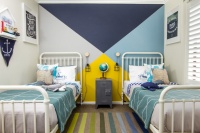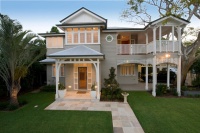Show Off the Bones of Your Home With Exposed Finishes
http://decor-ideas.org 10/10/2015 23:13 Decor Ideas
It’s not always deliberate that a great piece of work is left unfinished — see Schubert’s 8th Symphony or Mozart’s Requiem, for example. However, sometimes in the creative process there’s a decision to embrace the beauty in raw or “unfinished” materials. In the case of homes and other buildings, there might be an aesthetic choice about whether to expose certain elements — from structural steel to bare concrete to lightbulbs — that might ordinarily be hidden. Should you dare to bare? Check out these ideas for creating your own unfinished masterpiece.

Structural wood. Exposed structural wood is a much more common sight than some of the other materials in this story. The display of raw wood in a home creates a sense of bringing the natural world inside, and there’s a real-life essence to be gained from the look. Structural oak beams in particular bring so much feeling to a space. Dark woods are wonderful for a framing effect against crisp white walls and ceilings — great for demarcating areas of an open-plan space. And cherry and lighter woods work well as part of an overall scheme; bring them in through furniture, floors and staircases.

Electrical accessories. Wiring can be used in interesting ways. The most common is to hang lighting cables in an arrangement that suggests a sense of temporariness, as in an art studio or a construction site where string lights have been hung for a specific purpose. With a little imagination, the opportunities are endless. Cable coverings can be created in a vast array of materials and colors, for example. Just be sure the design is certified and installed by a qualified electrician.

Bricks (in an industrial property). Bricks and mortar are rough and cold and not always a look that comes to mind when you’re designing a cozy living room. Yet using exposed brick, especially on one feature wall, has great merit. The subtle irregularities in texture and color can really be brought to life with some skilfully placed lighting, such as the low table lamp that casts a warm glow in this warehouse-style apartment.

Bricks (in a period house). If you’re lucky enough to have a good-looking internal brick wall in your home, simply seal it with clear or colored products that can be found at any building supply store. If you’re not, then faux brick panels can be installed, the benefit of which is that you can identify a pattern and color that work for you.

Pipe. Pipe is a wonderful material with which to get creative. In fact, when I was training as a heating engineer, we would create small sculptures from copper pipe to demonstrate our skill. The most common raw finishes are steel and copper, though any finish can be achieved through painting, plating or polishing.
There’s a huge variety of fittings and fixings, as well as threading and bending techniques. Uses include water and gas, obviously, but pipe can also be used as cable trunking to form some interesting lighting features.
Any design that makes functional use of the pipe (as opposed to purely decorative) should be approved and installed by a qualified engineer who can certify that the work complies with regulations.

Concrete. One of the most overlooked building materials in its raw, unfinished form is concrete. But from prefabricated panels to polished countertops, it’s a highly versatile medium. Concrete also lends itself beautifully to a minimalist interior. There’s a nakedness to it that asks for solitary items of furniture or artwork in isolation.
The irregularities in concrete’s surface coloring work well with other materials that are natural or imperfect in some way. Acid-distressed glass is a great example.

Plywood. Sheet materials, especially plywood, can be a real boon to a homeowner’s budget. Although cost isn’t the ideal factor on which to base key design choices, it also can’t be ignored. Fortunately, plywood can look incredibly warm and stylish in its raw state, and it’s a brilliant base on which to redecorate at a later date if you tire of the look.
How to do it right? In a word: pine. Pine furniture, pine cabinets, pine shelves. Then understand that this really is an unfinished look, so choose light fixtures, tables, chairs and other features that also have a certain “makeshift” style. Try railings made of scaffolding poles, upturned crates for side tables and industrial-style wall lights.
Tour the rest of this rural Scottish property

Ductwork. The practical purpose of ductwork is to achieve proper air flow. A good duct system will keep the air throughout a home fresh and clean and make central parts of the property noticeably more comfortable.
OK, it’s a bold look to have ductwork out in all its glory, but design fortune favors the brave. All that raw metal can look severe, but it can also be striking in a minimal, contemporary room. Equally, it can look right at home in a space that incorporates a lot of other exposed raw building materials.
Be conscious of noise implications when situating the duct outlet, and make sure you get up there frequently to dust the metal. Keeping ductwork shiny will mean the difference between a really cool design feature and an unfortunate consequence of a poorly designed building.

Structural steel. Steel is a remarkable material for what it allows us to achieve in architectural design, to the point that we can appear to defy the laws of physics with floating staircases, split-level mezzanines and the like.
Structural steel can be left exposed to give a great industrial feel to an interior. Like exposed ductwork, this is a strong look and will work best if you really play it up as a feature. But again, check your regulations: Steel that’s integral to the structure of the building must be enclosed by fire-rated materials and cannot be left exposed.
Tell us: Have you exposed any raw materials in your home? Share your tips and photos in the Comments.
More: Pro Panel: ‘The Material I Love to Work With Most’
Related Articles Recommended












